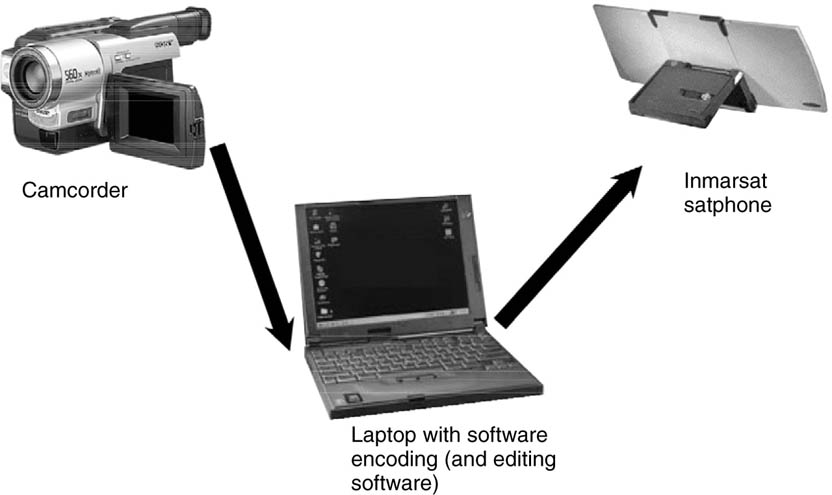Store and Forward
An alternative to the use of the low quality videophone is a Store and Forward system. It is important to note immediately that such systems do not operate in ‘live’ mode – they are intended for the transmission of material at higher quality, slower than real time. This means that every minute of material recorded will actually take several minutes to send.
A ‘live’ video transmission of a quality generally acceptable for a news broadcast requires a connection with a capacity of at least 2 Mbps. Clearly nothing near this data rate is currently available with the Inmarsat GAN service and to achieve this in a remote location, away from fixed high capacity terrestrial circuits, normally requires the use of a full-blown SNG system. However, although the Inmarsat GAN service is commonly used for live videophone broadcasts, a data rate of 64 or 128 kbps is simply not capable of providing sufficient capacity for high quality video.
However, by encoding the high quality video in a process where it is digitized and compressed at high bit rate, and then stored on a computer hard disk, the data can then be later transmitted through the Inmarsat GAN HSD system. Once received at the studio, it can then be integrated into the news broadcast for transmission.
This process is called ‘Store and Forward’ and gives users the ability to transmit high quality video and audio at relatively low data rates. Although the material is not live, it need not be more than a few hours old and the tradeoff in terms of portability makes it a very attractive alternative. In addition, Inmarsat GAN HSD channels are assigned on-demand and more conveniently available over a much wider area of the globe than Ku- or C-band SNG capacity.
The fundamental principle of the system is that video is played into a Store and Forward unit, which digitizes the video and stores it as a data file on the hard disk of a PC. Once this process has been completed, the Store and Forward unit can be connected to an Inmarsat GAN satphone, and a HSD call established to a companion unit at the destination. When the connection has been established the video/audio data file is transferred over the link and recorded as a data file at the destination. On completion of the transfer, the data file is played out as converted real-time video and audio.
As with the videophone, by using two satphones, the data rate is doubled, and for Store and Forward the file transmission time is halved.
The key to successful implementation of Store and Forward techniques is in the coding (digitization and compression) of the video. Uncompressed digital video would create enormous data files of gigabyte proportions. However, compression of the video during encoding reduces the file size to much more manageable proportions. In fact, compression ratios between 25:1 and 100:1 are typical with the actual compression selection depending upon the desired video quality.
Choosing a high sampling rate will result in higher quality pictures than a lower sampling rate, but will increase the transmission time. Store and Forward units offer a range of sampling rates, the highest of which will result in very good quality MPEG-2 pictures and sound being transferred at a rate of typically 50:1. One minute of video will therefore take approximately 50 min to arrive at the other end.
The length of the video and the sampling rate at which the video is digitized determine the size of the transmitted data file. The transmission times are thus fundamentally determined by three factors – the video sequence length, the video coding rate of the file and the data channel rate of 64 kbps for the Inmarsat GAN HSD service.
The video can be coded as an MPEG-2 or MPEG-4 compressed file. Some pictures coded at a lower data rate than typical MPEG-2 can have a ‘filmic’ look, reminiscent of 16 mm film. The quality of these pictures is often compared to VHS, but the overall effect is quite satisfactory for a news insert on a breaking story. The quality is often much improved if the shot scenes have high light levels, so that the pictures have few dark areas.
Store and Forward hardware
Highly portable Store and Forward systems were originally developed in the mid-1990s weighing only about 12 kg (25 lb) and designed for use in rugged conditions. A common system used in newsgathering in the field was the Toko VAST-p (no longer made). The VAST-p unit has been in use with a number of newsgatherers (both broadcasters and news agencies) for a number of years, but has now been superseded by newer technological solutions.
Commercial satellite frequency bands of interest for SNG are shown expanded

With the development of ever more powerful laptop PCs, there are now several Store and Forward systems that are based on software packages that run on a high-end laptop. The current generation of Store and Forward technology is based on using a laptop computer and a software encoder (unlike the earlier Toko VAST-p hardware encoding unit).
The video and audio is ‘captured’ as it is played into the laptop in real time via a ‘Firewire’ connection. The video and audio can then be edited if required using any one of a number of video editing packages of the user’s choosing, depending on the facilities and price.
Once it has been captured, and edited if required, the material is then compressed by software on the laptop using a software encoder using any one of a number of compression standards – the favourites at the time of writing are DivX, MPEG-2, MPEG-4 or Windows© Media 9.
The completed compressed file can then be sent via FTP (file transfer protocol) via an Inmarsat satphone (Mini-M or GAN) to the studio for subsequent transmission. A number of manufacturers produce systems based on this type of technology.
